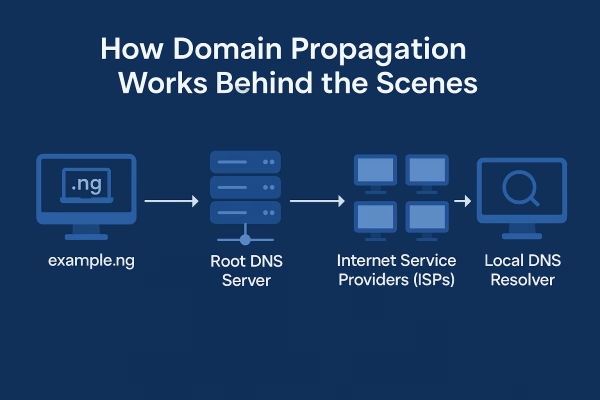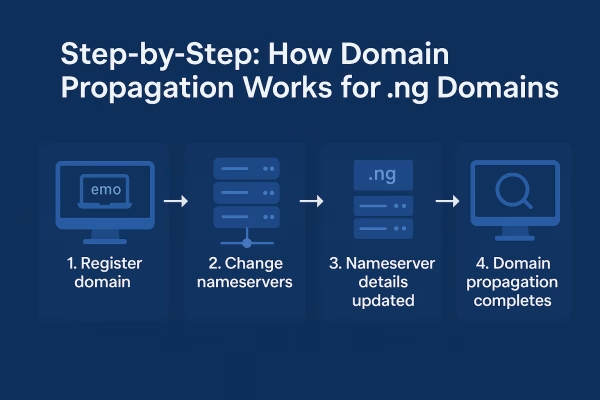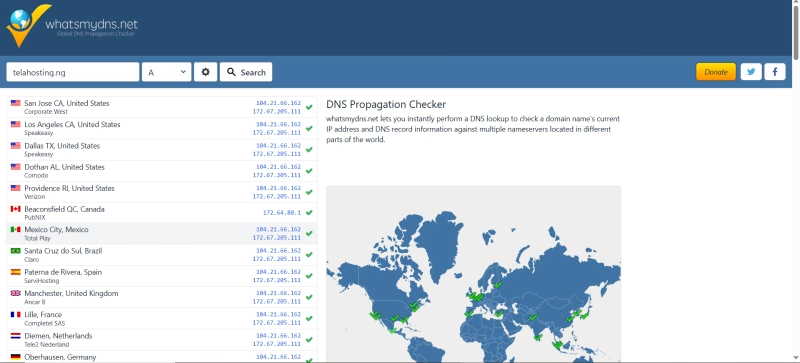
Understanding the Basics of Domain Names
Before diving into how domain propagation works, it’s important to first understand the foundation of it all: domain names. Every website you visit starts with a domain name which is your unique digital identity on the internet. This section breaks down what domain names are, how they’re structured (especially in the context of Nigeria’s .ng domain), and why they’re essential for navigating and building the web. Whether you’re a business owner or a curious learner, grasping this basic concept is the first step to mastering domain-related technologies.
What is a Domain Name?
A domain name is your digital address on the internet. Just like a house needs a postal address, websites need domain names so people can find them. For example, “telahosting.ng” is a domain name pointing to a Nigerian website.
Structure of a Domain Name
Domain names typically have two parts:
- Second-Level Domain (SLD): This is the main part (e.g., “telahosting” in telahosting.ng).
- Top-Level Domain (TLD): This is the suffix (e.g., “.ng”).
So, in a domain like business.ng, “business” is the SLD, and “.ng” is the country-code TLD for Nigeria.
Introduction to ccTLDs – The Case of .ng
What is a ccTLD?
A country code top-level domain (ccTLD) is a domain extension assigned to a specific country. Examples include:
- .ng for Nigeria
- .uk for the United Kingdom
- .ca for Canada
Who Manages the .ng Domain?
The .ng domain is managed by NiRA (Nigeria Internet Registration Association). NiRA is the official registry responsible for administering the .ng namespace, ensuring accessibility, affordability, and innovation within Nigeria’s digital landscape (source).
Why .ng Domains Are Important for Nigeria
- SEO relevance for local Nigerian search results
- Enhances national identity online
- Helps businesses build trust with Nigerian customers
What is Domain Propagation?
Definition and Core Concepts
Domain propagation refers to the time it takes for DNS changes (such as pointing your .ng domain to a new server) to spread across the internet. This isn’t instant. Different servers worldwide need time to recognize the new information.
How Domain Propagation Works Behind the Scenes

When you make changes to your DNS settings, like adding new name servers, the update must spread to:
- Root DNS servers
- Internet Service Providers (ISPs)
- Local DNS resolvers
Until all these systems are updated, visitors might still reach the old version of your site or experience errors.
The Role of DNS in Domain Propagation
What is DNS?
DNS (Domain Name System) is like the phonebook of the internet. It translates domain names like shop.ng into IP addresses so browsers can load the right website.
How DNS Affects Propagation Time
Each DNS server stores data in what’s called a “cache.” Until that cache is refreshed (which happens according to a TTL setting), changes won’t show. That’s why DNS propagation can take hours—or even days.
Step-by-Step: How Domain Propagation Works for .ng Domains

Registering a .ng Domain
To get started, you register a .ng domain via an accredited registrar like telaHosting, HostAfrica, or NiRA directly.
DNS Record Changes and Update Flow
After registration:
- You update DNS records in your registrar dashboard.
- Those changes are submitted to NiRA’s registry.
- DNS changes begin propagating across root servers and ISPs globally.
How It Propagates Globally
Even though your .ng domain may be for Nigeria, it still needs to be updated across global DNS networks. African ISPs may update quicker than others, but users in other countries may experience delays.
How Long Does Domain Propagation Take?
Typical Timeline
Most propagation completes within:
- 4–8 hours for many .ng domains
- Up to 48 hours globally
Factors Affecting Propagation Speed
- Time-to-Live (TTL) settings
- Registrar efficiency
- DNS hosting provider
- User’s ISP cache settings
Common Issues During Propagation
Delay in DNS Updates
Some ISPs update slower than others. This delay can make it seem like your site is down when it’s just not updated for your location.
Cached Data Problems
If your browser or system has cached the old DNS, you might not see the updates even when they’re live.
Regional Inconsistencies
Someone in Lagos may see the updated .ng site, while someone in Abuja or London may still see the old version or a 404 page.
Tools to Check Domain Propagation Status
Best Free Tools
Use these to check your domain’s global propagation status:

How to Use Them for .ng Domains
Simply input your .ng domain and select the record type (A, CNAME, etc.). The tool will show propagation status from multiple global locations.
Best Practices to Minimize Propagation Time
Set Correct TTL
Lower your TTL to around 300 seconds (5 minutes) before making changes.
Choose Reliable DNS Providers
Opt for DNS services like Cloudflare or AWS Route 53, which are known for fast updates.
Flush Local DNS Cache
Clear your device’s DNS cache after making changes:
- Windows:
ipconfig /flushdns - Mac:
sudo killall -HUP mDNSResponder
Propagation vs Domain Resolution
Key Differences
- Propagation = DNS record update delay across the internet
- Resolution = When a DNS server finds the correct IP for a domain
Misconceptions Cleared
Many think their domain is “not working” during propagation. In reality, it’s just not updated everywhere yet.
DNS Records Involved in Propagation
A, CNAME, MX, TXT, NS Explained
| Record | Purpose |
|---|---|
| A Record | Points domain to an IP address |
| CNAME | Points one domain to another |
| MX | Email routing |
| TXT | Holds text data for verification (like SPF, DKIM) |
| NS | Lists authoritative name servers for the domain |
Real-Life Case Study: A .ng Domain Going Live
Timeline Breakdown
- Day 1: Registered mysite.ng
- Day 1: Updated DNS (Cloudflare)
- Hour 2: Live in Lagos
- Hour 6: Live in London
- Hour 20: Fully propagated worldwide
Performance Metrics
After propagation, the .ng site showed:
- 99.9% uptime
- Global response time under 1.2s
- Full SEO indexing in 48 hours
Tips for Businesses Using .ng Domains
SEO Benefits
Search engines favor local TLDs in country-specific results. A .ng domain ranks better on Google.com.ng.
Trust Factor in Nigerian Market
Customers associate .ng domains with authenticity and local relevance.
How Registrars Handle Propagation for .ng Domains
Role of NiRA
NiRA manages the .ng zone and ensures:
- Stable DNS infrastructure
- Secure registry operations
- Fast propagation updates
Recommended Registrars
- telaHosting
- HostAfrica
- Smartweb
FAQs About Domain Propagation
1. What is domain propagation in simple terms?
It’s the time it takes for DNS changes to update across all servers worldwide.
2. Why does domain propagation take so long?
Because DNS information is cached in many servers, and each updates at its own pace.
3. How do I know if my .ng domain has propagated?
Use a tool like WhatsMyDNS.net.
4. Can I speed up propagation?
Yes—by lowering TTL settings before making changes.
5. Will email be affected during propagation?
Yes, if you change MX records, emails may be delayed or misrouted temporarily.
6. Is domain propagation different for .ng than for .com?
No, the process is technically similar, though the local infrastructure (.ng via NiRA) may affect speed.
Conclusion – Making the Most of Your .ng Domain
Understanding what is domain propagation is essential for anyone managing websites, especially with a .ng domain. While propagation can’t be skipped, you can reduce wait times by following best practices. With the right tools and knowledge, you’ll ensure your Nigerian online presence is strong, reliable, and always visible.